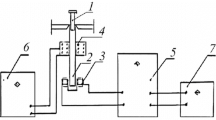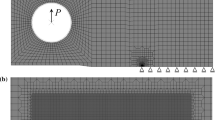Abstract
To provide a basis for estimating fatigue life in large rotating generator shafts subjected to transient oscillations, a study is made of fatigue crack propagation in Mode III (anti-plane shear) in torsionally-loaded spheroidized AISI4340 steel, and results compared to analogous behavior in Mode I. Torsional S/N curves, determined on smooth bars containing surface defects, showed results surprisingly close to expected unnotched Mode I data, with lifetime increasing from 104 cycles at nominal yield to 106 cycles at half yield. Fatigue crack growth rates in Mode III, measured on circumferentially-notched samples, were found to be slower than in Mode I, although still power-law related to the alternating stress intensity(△K III) for small-scale yielding. Mode III growth rates were only a small fraction (0.002 to 0.0005) of cyclic crack tip displacements(△CTD III) per cycle, in contrast to Mode I where the fraction was much larger (0.1 to 0.01). A micromechanical model for Mode III growth is proposed, where crack advance is considered to take place by a Mode II coalescence of cracks, initiated at inclusions ahead of the main crack front. This mechanism is consistent with the crack increment being a small fraction of △CTDIII per cycle.
Similar content being viewed by others
References
A. Abolins, D. Lambrecht, J. S. Joyce, and T.L. Rosenberg:IEEE Transactions for Power Apparatus and Systems, 1976, vol. 95, p. 14.
U.C. Jackson, S.D. Umans, R.D. Dunlop, S.H. Horowitz, and A. C. Parikh:IEEE Transactions for Power Apparatus and Systems, 1979, vol. 98, p. 2299.
R. D. Dunlop, S. H. Horowitz, A.C. Parikh, M. C. Jackson, and S.D. Umans:IEEE Transactions for Power Apparatus and Systems, 1979, vol. 98, p. 2308.
M. C. Jackson: MIT EPSEL Report No. 55, August 1978, Electric Power Systems Engineering Laboratory, M.I.T., Cambridge, MA 02139.
D.N. Walker, C.E. Bowler, and R. L. Jackson: IEEE Transactions for Power Apparatus and Systems, 1975, vol. 94, p. 1878.
W. W. Wilkening, F. A. McClintock, and R.O. Ritchie: Annual Report No. 1 to D.O.E., Division of Energy Conservation, M.I.T. Fatigue and Plasticity Laboratory Report No. FPL/R/79/1028, October 1979.
R. O. Ritchie and F. A. McClintock: Annual Report No. 2 to D.O.E., Division of Energy Conservation, M.I.T. Fatigue and Plasticity Laboratory Report No. FPL/R/80/1037, October 1980.
R. Placek, R. Williams, O. Klufas, and S. Actams: “Torsional Fatigue Strength of Large Turbine-Generator Shafts,” Report No. RP1531 to E.P.R.I., General Electric Company, Large Steam Turbine-Generator Division, Schenectady, NY 12345.
H. E. Lokay, D. G. Ramey, and W. R. Brose:Proc. 40th American Power Conf., Illinois Institute of Technology, Chicago, IL, 1978, vol. 40, p. 1106.
M. E. Fine and R. O. Ritchie: inFatigue and Microstructure, American Society for Metals, Metals Park, OH, 1979, p. 245.
N. E. Dowling, W. R. Brose, and W. K. Wilson: inFatigue under Complex Loading: Analysis and Experiments, Society of Automotive Engineers, Warrendale, PA, 1971, vol. AE-6, p. 55.
J. A. H. Huit and F. A. McClintock:Proc. Ninth Intl. Congress on Applied Mechanics, University of Brussels, Belgium, 1957, vol. 8, p. 51.
J.B. Walsh and A.C. Mackenzie:J. Mech. Phys. Solids, 1959, vol. 7, p. 247.
J. R. Rice:Intl. J. Fract. Mech., 1966, vol. 2, p. 426.
J. R. Rice: inFracture: An Advanced Treatise, H. Liebowitz, ed., Academic Press, New York, NY, 1968, vol. II, p. 248.
F. A. McClintock:Proc. Intl. Conf. Fatigue of Metals, London, U.K., Instit. Mech. Engineers, 1956, p. 538.
J. A. H. Hult:Trans. Royal Inst. of Tech., Stockholm, Sweden, No. 119, 1958.
I. Kayan:Bull. Tech. Univ. Istanbul, 1961, vol. 14, p. 45.
F. A. McClintock: inFracture of Solids, TMS-AIME Conf. Ser. 20, Interscience, 1963, p. 65.
M. Kage and H. Nisitani:Bulletin of JSME, 1978, vol. 21, p. 948.
L.P. Pook and J.K. Sharpies:Intl. J. Fracture, 1979, vol. 15, p. R223.
L. P. Pook and A. F. Greenman: inFracture Mechanics, Amer. Soc. Test. Matl., Philadelphia, PA, ASTM STP, 1979, vol. 677, p. 23.
L. P. Pook:Proc. European Congress on Fracture III, J. C. Radon, ed., Pergamon Press, 1980, p. 143.
N. J. Hurd and P. E. Irving: inDesign of Fatigue and Fracture -Resistant Structures, ASTM STP in press, American Society for Testing and Materials, Philadelphia, PA, 1981.
F. Hourlier, D. McLean, and A. Pineau:Metals Tech., 1978, vol. 5, p. 154.
R. O. Ritchie:J. Eng. Mater. Technol., Trans. ASME Ser. H., 1977, vol. 99, p. 195.
M. A. Ritter: “Fatigue Crack Propagation in Mode III,” S.M. Thesis, Dept. of Mech. Eng., M.I.T., Cambridge, MA 02139, December 1980.
R.O. Ritchie and K. J. Bathe:Intl. J. Fracture, 1979, vol. 15, p. 47.
H. Tada, P. C. Paris, and G. R. Irwin: inThe Stress Analysis of Cracks Handbook, Del Research Corporation, Hellertown, PA, 1973, p. 27.1–3.
C. F. Shih:J. Mech. Phys. Solids, 1981, vol. 29, in press.
F. W. Griese:Stahl u. Eisen, 1979, vol. 99, p. 193.
N.J. Hurd and P. E. Irving:Proc. European Congress on Fracture III, J. C. Radon, ed., Pergamon Press, 1980, p. 239.
R. C. Shah: American Society for Testing and Materials, 1973, inASTM STP, 1973, vol. 560, p. 29.
W.K. Wilson: Westinghouse Research Report 69-IE7-FMECH-R1, Westinghouse Research Laboratories, Pittsburgh, PA, June 1969.
L.P. Pook:Intl. J. Fracture, 1977, vol. 3, p. 205.
F. A. McClintock and R. M. Pelloux: Boeing Technical Report No. Dl-82-0708, Boeing Company, Seattle, WA, 1968.
M. Kikukawa, M. Jono, and M. Adochi: American Society for Testing and Materials, inASTM STP, 1979, vol. 675, p. 243.
V. A. Tipnis and N. H. Cook:J. Basic Eng., Trans. ASME Ser. D., 1967, vol. 89, p. 533.
Author information
Authors and Affiliations
Additional information
Formerly with Massachusetts Institute of Technology, Cambridge, MA
Formerly with M.I. T.
Rights and permissions
About this article
Cite this article
Ritchie, R.O., McClintock, F.A., Nayeb-Hashemi, H. et al. Mode III fatigue crack propagation in low alloy steel. Metall Trans A 13, 101–110 (1982). https://doi.org/10.1007/BF02642420
Received:
Issue Date:
DOI: https://doi.org/10.1007/BF02642420




